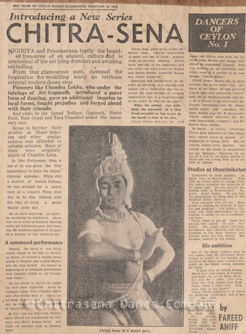Out of the eight projects supported by the MOWCAP-ACC Small Grants Programme for 2020, two grants will fund Sri Lankan organisations in their conservation efforts of Sri Lanka’s cultural heritage, as well as their plans to make these archives freely accessible.
The organisations supported are; Chitrasena Vajira Dance Foundation (CVDF), who would be using the MOWCAP-ACC grant in their project to preserve Sri Lanka’s Dance and Dance Theatre heritage; Janamihira Nirmana organisation collaborating with the Library of the University of Peradeniya, who would be utilising the grant to transcribe and translate an ancient medical manuscript in order to bring more exposure to Sri Lanka’s indigenous medicine.
CVDF comprising of Chitrasena Kalayathanaya (Dance School) and the Chitrasena Dance Company have been major contributors to the growth of Sri Lankan dance and Dance theatre dating back to the first half of the 20th century. Over the 75 years of their existence, they have amassed a wealth of historical material which consists of; program books, cast lists, newspaper articles, photographic images, musical scores, video and audio recordings, props in addition to costumes and their design illustrations.
 |
 |
 |
 |
 |
|
Using the grant, CVDF completed the 1st phase of their project in 2019; and this year CVDF will implement the 2nd phase to conserve the Dance Heritage of Sri Lanka as follows:
- Conserve these archives systemically by obtaining insight and advice from specialists in order to adopt the appropriate techniques for their storage and conservation.
- Comprehensively catalogue and digitize the archives in order to effectively manage and access them
- Make these resources accessible via the internet and on site to the wider public
Janamihira Nirmana organisation collaborating with the Library of the University of Peradeniya wishes to transcribe a rare medical palm-leaf manuscript, known as the Vasudeva Nighantuva (illustrated in the image below), and then translate and publish commentaries in English. There are 25 copies of this manuscript recorded in multiple temple libraries and the University of Peradeniya in a survey conducted between 1959 and 1964.
They hope to carry out this project as follows:
- Conduct a field survey allowing them to pinpoint viable manuscripts. The transcripts of these copies will be compared and any significant differences will be identified.
- The manuscripts will be then transcribed and reviewed by an expert committee before writing commentaries.
- Finally, the commentaries will be translated into English and then published.











